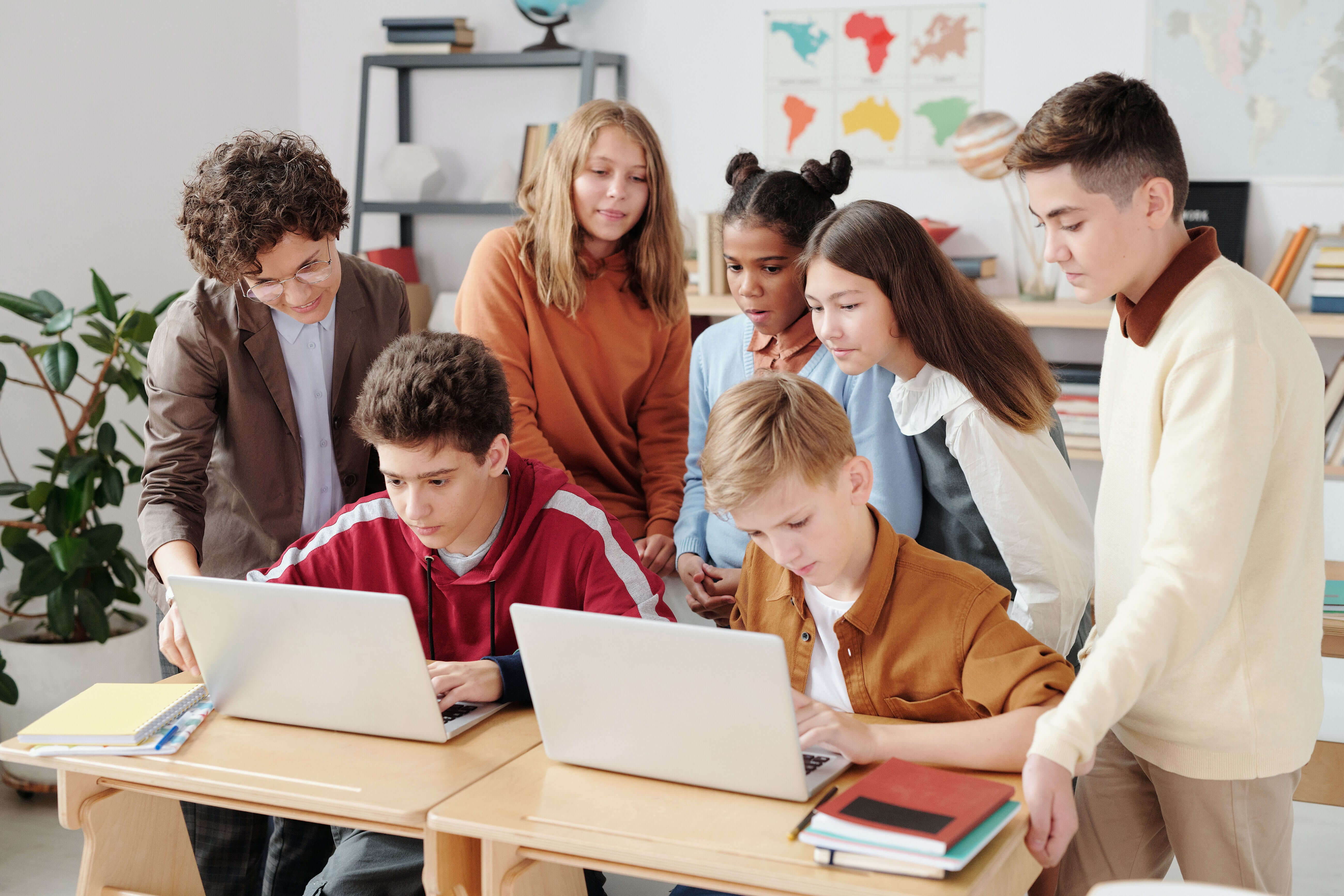Technology That is Used in The Classroom 2025

In recent years, we have witnessed a rapid transformation in education with the rise of online classrooms and hybrid learning models. Technology has revolutionized how teachers engage with their students, opening up new avenues for the use of technology in teaching and learning.
The global pandemic of 2020 and subsequent lockdowns acted as a catalyst for the adoption of online learning. Since then, educators and students alike have recognized the benefits of digital tools in the classroom, such as increased flexibility, personalized learning, and enhanced access to educational resources. The hybrid learning model, which combines both in-person and online instruction, has also gained popularity, allowing for a seamless transition between physical and virtual learning environments.
As we delve into the teaching landscape of 2025, we, through this post, aim to explore the technology that is used in the classrooms, focusing primarily on the virtual or online classroom environment:
Part 1: Advantages of Technology in The Classroom
Here are the advantages of using technology in the classroom that highlight the transformative impact, empowering teachers to create engaging and student-centered learning environments:
1. Enhanced Engagement and Interactivity
Multimedia presentations, interactive learning tools, and gamified applications capture students' attention and make learning more enjoyable. The increased engagement can lead to improved knowledge retention and an in-depth understanding of the subject.
2. Personalized Learning
Technological tools in education enable customized learning experiences unique to each student's needs and learning pace. Adaptive learning platforms and intelligent algorithms can analyze student performance data and provide targeted recommendations, allowing teachers to customize instruction and provide individualized support.
3. Access to Vast Educational Resources
The Internet provides students and teachers instant access to many educational resources beyond traditional textbooks. Online libraries, educational websites, and digital archives offer diverse materials, including articles, videos, simulations, and interactive content, expanding learning opportunities and fostering independent research skills.
4. Collaboration and Communication
Virtual classrooms, discussion boards, and messaging platforms enable students to interact with their peers and instructors, share ideas, ask questions, and receive timely feedback. This promotes teamwork, enhances communication skills, and creates a sense of community, even in online environments.
5. Flexibility and Accessibility
Online classrooms allow for greater flexibility regarding time and location. Students can access learning materials, complete assignments, and participate in discussions from anywhere via the Internet. Such flexibility accommodates diverse schedules and learning styles, making education more accessible to students with different needs and circumstances.
6. Real-World Application and Skill Development
Students gain practical skills applicable to their future careers, from productivity tools and online research to multimedia creation and data analysis. Additionally, incorporating technology in the classroom fosters digital literacy and critical thinking, empowering students to navigate and evaluate information in an increasingly digital world.
Part 2: Technology That Is Used in The Classroom - Virtual/Online
In this part, we shall talk about some of the vital technology tools used in the classroom in detail:
1. Video Conferencing Platforms
Video conferencing platforms are essential ICT tools used in classroom teaching, enabling real-time communication and collaboration between teachers and students. These platforms offer features that mimic face-to-face interactions, making remote learning more engaging and interactive.
How to Choose a Video Conference Platform:
Key factors to consider while choosing a video conference platform for integrating technology in the classroom are:
- User-Friendliness: The platform should be intuitive and easy for teachers and students to navigate, ensuring a smooth learning experience.
- Stability and Reliability: Go for a platform that offers stable connections and minimal disruptions, ensuring seamless communication throughout the class.
- Security and Privacy: Prioritize platforms that provide robust security measures to protect students' privacy and sensitive information.
- Interactive Features: Evaluate the platform's features, such as screen sharing, breakout rooms, chat functionality, and virtual whiteboards, facilitating collaboration and active participation.
2. Learning Management Systems (LMS)
Learning Management Systems (LMS) are comprehensive platforms that centralize course materials, assignments, assessments, and communication tools. LMS platforms enhance the virtual classroom experience by providing a structured and organized learning environment.
The Benefits of Using an LMS:
Using an LMS in the virtual classroom offers numerous benefits:
- Course Management: Teachers can easily organize and manage course materials, create lesson plans, and schedule assignments using the LMS.
- Content Delivery: LMS platforms allow teachers to upload and share multimedia resources, including videos, documents, and interactive content, ensuring easy access for students.
- Assessment and Feedback: LMS platforms facilitate creating and administrating quizzes, tests, and assignments. Teachers can provide timely feedback and grades, promoting continuous learning and progress tracking.
- Communication and Collaboration: LMS platforms offer discussion boards, messaging systems, and announcement features to facilitate communication between teachers and students, as well as foster collaboration among peers.
3. Webcam - OBSBOT Tiny 2 4K Webcam
The OBSBOT Tiny 2 is an advanced AI-powered webcam to enhance the virtual classroom experience. Packed with innovative features, this webcam empowers teachers to deliver engaging and interactive lessons in the online learning environment.
Key Features of OBSBOT Tiny 2:
- Whiteboard Mode: The dedicated Whiteboard Mode helps teachers write, draw, and annotate during virtual lessons, enhancing visual explanations and content delivery.
- Auto-Framing: The AI-powered auto-framing feature automatically detects and tracks the teacher's movements within the classroom. This feature ensures that the teacher remains in the frame, regardless of their position.
- 4K Resolution: The OBSBOT Tiny 2 captures high-resolution video, providing clear and detailed visuals for students. Its AI-powered tracking and focusing capabilities ensure that teachers are in sharp focus, maintaining a professional and engaging presence in virtual classrooms.
- Gesture Control: With built-in magic gesture 2.0 recognition technology, the OBSBOT Tiny 2 allows teachers to control various aspects of their virtual classroom experience through hand gestures, like dynamic zoom in/out, 4 times zoom, or select/cancel target.
- Voice Control: The OBSBOT Tiny 2 supports voice commands, providing teachers with hands-free control over camera functions and settings. Teachers can operate the webcam using simple voice commands, such as adjusting zoom, changing positions, tracking, unlocking, and more, enhancing convenience and flexibility during virtual classes.
- Noise Reduction and Audio Enhancement: The OBSBOT Tiny 2 utilizes advanced audio algorithms to reduce background noise and enhance voice clarity. It is a vital feature to ensure that teachers' voices are crystal clear for effective communication with students during virtual classes.
In short, the OBSBOT Tiny 2 AI Classroom Webcam is a revolutionized teaching technology in the classroom, offering teachers advanced features that enhance interactivity, mobility, and audiovisual quality.
4. Technology Tools for Communication and Collaboration
Effective communication plus collaboration are essential for a successful virtual classroom environment. Technology tools for communication and cooperation facilitate seamless interaction among teachers and students, fostering engagement and teamwork.
Here Are the Top 3 Collaboration Tools You Can Try:
1. Microsoft Teams
Microsoft Teams is a comprehensive collaboration platform that combines chat, video conferencing, file sharing, and project management features. It allows teachers and students to communicate in real time, collaborate on documents, and organize virtual meetings or group discussions.
2. Google Workspace
Google Workspace offers collaboration tools, including Google Docs, Sheets, Slides, and Google Meet. These tools enable real-time document editing, simultaneous collaboration, and video conferencing, making it easier for teachers and students to work together on assignments and projects.
3. Slack
Slack is a famous messaging and collaboration platform that simplifies communication and enhances teamwork. It offers channels for group discussions, direct messaging, file sharing, and integrations with various apps and tools. Slack facilitates quick and efficient communication between teachers and students, promoting collaboration and knowledge sharing.
5. Technology Tools for Quiz and Assessment
Assessing students' understanding and progress is a critical aspect of education. Technology tools designed for quizzes and assessments offer efficient ways to create, administer, and grade assessments in the virtual classroom environment.
The Top 3 Assessment Tools You Can Try Are:
1. Kahoot!
Kahoot!, a game-based learning platform allows teachers to create interactive quizzes, surveys, and discussions. It engages students with its gamified approach, promotes active participation, and provides instant feedback, making assessments fun and interactive.
2. Quizizz
Quizizz is another engaging quiz platform that offers a wide range of pre-created quizzes or allows teachers to create their own. It supports asynchronous learning, enabling students to complete quizzes at their own pace while still offering the element of competition and engagement.
3. Edpuzzle
Edpuzzle is a tool specifically designed for assessing understanding through video-based assessments. Teachers can create interactive video lessons, embed questions, and track student responses. Edpuzzle provides valuable insights into student comprehension and engagement with the material.
6. Technology Tools for Design and Development
Technology tools for design and development enable students to unleash their creativity and create visually compelling projects in the virtual classroom. These tools support various aspects of design, multimedia creation, and development.
Top 3 Design Tools You Can Try:
1. Canva
Canva is a known user-friendly graphic design platform with multiple templates, images, and design elements. It allows students to create visually appealing presentations, infographics, posters, and more without requiring extensive design skills.
2. Adobe Creative Cloud
Adobe Creative Cloud is a comprehensive design software suite, including Photoshop, Illustrator, InDesign, and more. These tools provide advanced photo editing, graphic design, and page layout capabilities, empowering students to create professional-quality visual content.
3. Scratch
Scratch is one block-based programming language developed by MIT that introduces students to coding and interactive multimedia creation. It allows students to design and develop interactive stories, animations, and games, fostering computational thinking and creativity.
7. Virtual Whiteboards and Annotation Tools
Virtual whiteboards and annotation tools replicate the traditional ICT tools used in classroom teaching, allowing teachers to present information, explain concepts, and collaborate with students in a digital format.
Here Are Some Benefits of Using Virtual Whiteboards:
- Enhanced Visual Communication: Virtual whiteboards enable teachers to illustrate concepts, draw diagrams, and annotate content in real time, improving visual communication and clarity.
- Collaborative Learning: The whiteboards facilitate collaborative learning by allowing students to contribute, brainstorm ideas, and work together on shared virtual canvases, fostering active engagement and teamwork.
- Remote Accessibility: Access virtual whiteboards from anywhere with an Internet connection. Thus, teachers and students can collaborate and interact in remote learning environments.
- Content Preservation and Sharing: These whiteboards can often save and share the created content so students can revisit the information later for review or reference.
- Interactive and Dynamic Presentations: Teachers can create dynamic presentations by incorporating multimedia elements, such as images, videos, and widgets, making lessons more engaging and interactive.
Part 3: Technology That Is Used in The Classroom - Traditional

Now, we shall talk about some traditional technology tools for the classroom as well.
1. Interactive Whiteboards
Interactive whiteboards are a popular technology tool used in traditional classrooms to enhance teaching and learning experiences. These large display boards are connected to a computer, allowing teachers to interact with the content using a touch or a stylus.
Key Features and Benefits of Interactive Whiteboards:
- Multimedia Integration: Interactive whiteboards enable teachers to display and interact with various multimedia resources, including videos, images, and interactive presentations. This feature enhances the visual appeal of lessons and facilitates dynamic and engaging instruction.
- Annotation and Collaboration: Teachers can write, draw, and annotate directly on the interactive whiteboard, making it easier to highlight key points, explain concepts, and illustrate diagrams. Additionally, interactive whiteboards promote collaboration by allowing multiple users to interact simultaneously, fostering student engagement and participation.
- Integration with Digital Resources: Interactive whiteboards can connect to the Internet, allowing teachers to access online resources and incorporate web-based content into their lessons. This capability expands the range of educational materials available to teachers, providing access to up-to-date information and diverse learning resources.
- Interactive Learning Activities: Interactive whiteboards support using interactive learning activities, such as quizzes, games, and simulations. These activities promote active participation, critical thinking, and problem-solving skills among students, making learning more enjoyable and impactful.
2. Presentation Software
Presentation software, such as Microsoft PowerPoint or Google Slides, is a widely used technology tool in traditional classrooms. It allows teachers to create visually appealing and organized presentations to deliver instructional content.
Features and Benefits of Presentation Software:
- Visual Organization: Presentation software provides templates, themes, and formatting options that help teachers create visually organized and engaging slides. The use of headings, bullet points, images, and multimedia elements enhances the clarity and impact of the presented information.
- Multimedia Integration: Presentation software allows teachers to embed multimedia elements, including images, videos, audio clips, and hyperlinks. This multimedia integration enhances content delivery, appeals to different learning styles, and makes lessons more interactive and engaging.
- Seamless Transition and Animation Effects: Presentation software offers transition and animation effects that enable smooth and visually appealing transitions between slides or elements. These effects can strategically guide attention, emphasize key points, and maintain student engagement throughout the presentation.
- Collaboration and Sharing: Presentation software often includes collaboration features that allow multiple users to contribute and edit slides simultaneously. This facilitates group projects and encourages student collaboration, fostering teamwork and peer learning.
- Assessment and Feedback: Presentation software enables teachers to create interactive quizzes, polls, and surveys within their presentations that help assess students' understanding, gather feedback, and promote active participation during the lesson.
3. Document Cameras
Document cameras, also known as visualizers or digital visual presenters, are technology tools used in traditional classrooms to display and share physical documents, textbooks, and other objects with the entire class. They consist of a camera mounted on an adjustable arm that captures real-time images or videos of the object and displays them on a larger screen or projector.
Key Features and Benefits of Document Cameras:
- Visualize Physical Materials: Document cameras enable teachers to display physical materials, such as textbooks, worksheets, artwork, science experiments, or manipulatives, to the entire class. This allows students to see details, follow the teacher's explanations, and engage in interactive discussions about the displayed materials.
- Real-Time Demonstrations: With a document camera, teachers can demonstrate procedures, experiments, or step-by-step processes in real time. By displaying their actions on a larger screen, teachers can ensure that all students clearly understand the demonstrated concepts or techniques.
- Annotate and Highlight: Many document cameras have built-in annotation features, allowing teachers to write, draw, or highlight specific sections of the displayed materials. This interactive element helps focus students' attention, emphasize key points, and encourage active participation during discussions or visual content analysis.
- Record and Capture Images: Some document cameras have recording capabilities, enabling teachers to capture images or videos of the displayed content. This feature allows for later review or sharing of the recordings with absent students or for reference in future lessons.
4. Classroom Response Systems (Clickers)
Classroom Response Systems, commonly known as clickers or student response systems, are technology tools used in traditional classrooms to engage students in real-time interactive activities and assessments. These systems consist of handheld devices (clickers) for students and a receiver connected to the teacher's computer.
Key Features and Benefits of Classroom Response Systems:
- Immediate Feedback: Teachers can pose questions, quizzes, or surveys to the entire class, and students respond using clickers. The system collects and displays the responses instantly, allowing teachers to gauge student understanding, identify misconceptions, and provide immediate feedback to guide further instruction.
- Active Participation: Clickers promote active participation as students can actively respond to questions and engage in discussions or debates. The anonymity provided by the system can encourage students to share their thoughts without fear of judgment, fostering a more inclusive and participatory classroom environment.
- Formative Assessment: Teachers can conduct formative assessments on the spot, gaining valuable insights into student comprehension and adjusting instruction accordingly. Teachers can identify specific areas of strength and weakness, address misconceptions, and tailor instructional strategies to meet individual student needs.
- Data Collection and Analysis: Classroom Response Systems provide teachers with data and analytics on student performance and understanding. This data can track personal and class progress, identify trends or patterns, and inform instructional decisions or interventions.
- Interactive Learning Activities: Classroom Response Systems support various interactive learning activities, such as quizzes, polls, surveys, and games. These activities increase student engagement, promote critical thinking, and encourage collaborative problem-solving.
So, these were a few traditional technology that is used in the classroom.
Conclusion
So, guys, what do you think? Are you ready to start integrating technology in the classroom? We gave you all the information you need, along with the right equipment, platforms, LMS, and ICT examples in the classroom. Do try to incorporate and share this information with your known teachers so they can ease their daily classes and enhance the experience for their students. Lastly, we again recommend the OBSBOT Tiny 2 as the top-most technological tool in education.















